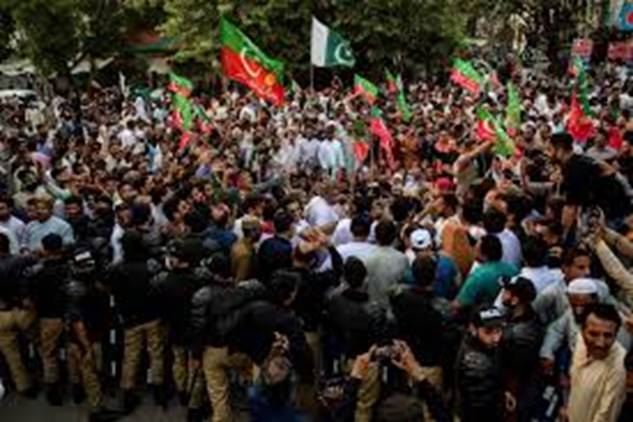
The Pakistani State Stumbles into One Conflict with Its Own Population after the Other
By Umair Javed
Lahore, Pakistan

From the national security perspective of Pakistan, the country is besieged by hostile forces seeking to undermine the security apparatus and/or alter its geographic integrity altogether.
On this list, the identity of external hostile forces remains largely unchanged since 1947, though the Americans tend to drop in and out depending on regional considerations.
The list of internal collaborators/ fifth columnists sees a bit more churn. At various times, it has featured communists, socialists, mainstream political parties questioning military rule, mainstream political parties demanding federalism, mainstream political parties seeking constitutional rule, a few shades of Sharia-demanding Islamists, and, of course, ethnonationalists striving for political and cultural autonomy.
While most others go in and out depending on political circumstances, and the communists/socialists remain a figment of the distant past, ethnonationalists occupy a great deal of head and policy space for national security policymakers and thinkers (the latter term used here very broadly).
A common narration from their perspective is that ethnonationalist movements — principally the Pakhtun nationalists in KP and the Baloch nationalists in Balochistan ( Bengalis in the past, and occasionally, Sindhis and Mohajirs too) — never accepted Pakistani statehood. In line with aspirations of self-determination, these groups sought independence or merger with neighboring states from day one.
This was their default position at the time of statehood, which the Pakistani state — like any other territory-protecting entity — had no option but to deal with as a security threat. In other words, according to this perspective, the state’s relationship with these political groups didn’t turn sour because of the actions of the state; instead, one side was committed to rejecting the state from the outset.
Like most ideas that states, especially insecure ones, believe, there may be an occasional figment of truth in it. Hard-liners and maximalists are present in any social and political movement, and there is no reason ethnic movements would be different.
But where the NatSec lot gets its analysis wrong is in its reading of history. Hard-liners did not necessarily have the upper hand in movements from day one. Instead, the turn towards secessionism usually emerged because of the chain of events featuring the state’s national security apparatus and various identity groups.
The clearest example of this phenomenon is in the case of Bangla nationalism between 1947 and 1971. The Muslim League won its heaviest mandate in the 1946 elections in East Bengal on an explicit platform for an autonomous state for Indian Muslims. The same region saw considerable mobilization for the Muslim nationalist cause in the years leading up to statehood, and Bengali Leaguers formed a central part of the party leadership.
The relationship soured post-1947 because of the denial of linguistic rights and the forced centralization of provincial government functions. The rout of the Muslim League at the hands of the United Front coalition in the 1954 election was, in fact, a symptom of malignant central rule, and not necessarily a reflection of repressed secessionism.
Instead of accommodation through the democratic process, the security state doubled down on centralization through the One Unit scheme, inequitable distribution of resources, and continued repression of provincial politicians. The final straw was a denial of the Awami League’s popular mandate after the 1970 election.
In its current iteration, the Baloch insurgency appears to unfold broadly along the same pattern. Its origins lie in the heavy-handedness of a military regime against a popular politician, leading to the latter’s killing. Barring occasional efforts by elected central governments to forge a representative arrangement, the province’s governance is outsourced to the security establishment.
In frequent displays of viceregal power, parties are created at a whim, election results are manipulated or repressed, assembly compositions are curated, citizens are disappeared, and non-violent social movements for rights — whether in Gwadar or the BYC — are policed, harassed, and criminalized. If there was a guidebook for how to empower hard-liners, it would likely include all of these steps.
The same pattern is now visible in KP. The case here is even more exasperating since Pakhtun nationalism was largely accommodated within federal politics by the late 1990s. If anything, the rise of the PTI — a party with countrywide appeal paying homage to Pakistaniat — and its entrenched popularity in the province showed the region’s politics evolving towards a different, more centripetal, direction.
What changed? Militarised rule of the province’s peripheries, regional dynamics created by the imperial excursion in Afghanistan, and the absence of any transparency or accountability of security policies helped provide conditions for ethnic rights-based mobilization through the PTM.
Whatever its critics may say, there is no denying PTM’s organic appeal . It speaks to the marginalized reality of large swathes of the population; a marginalization, that the state has enabled, if not outright created. And like clockwork, the response has been to coerce its supporters, subjugate its leaders, and declare it to be a proscribed organization.
The final, and frankly surreal, straw is the chain of events leading to PTI becoming accommodating of ethnic nationalist undertones in its politics, with parts of its leadership and its support base finding common cause with the PTM. In a truly remarkable feat of own-goalism, the biggest civilian proponent of both Pakistani nationalism and centralized state power is now a skeptic. This is the grand total of what denial of an electoral mandate, harassment and coercion, and pitting province against province will likely achieve.
Adopting a national security perspective makes a state see the world in terms of threats and conspiracies. But there is a reason why most successful states, ie, those with stable, productive relations with their citizens, only draw on this perspective as one among several.
Most will prioritize development, enhancement of human capability, and cultural fulfillment as valuable goals as well. Not the Pakistani state, though. Blinkers on, it stumbles into one conflict with its own population after the other. And then wonders why so many act hostile to it.
(The writer teaches sociology at Lums. Dawn)

